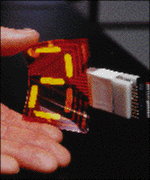Light-emitting polymer technology
satisfies display requirements
Focused on determining and satisfying commercial opportunities for its light-emissive polymer (LEP) technology, UNIAX (Santa Barbara, CA) has completed a clean room and prototype manufacturing line for its first LEP product offering–a flexible alphanumeric display. The display is based on electronic polymers that are synthesized to exhibit the electrical and optical properties of metals or semiconductors.
Combining the emission characteristics of LEDs and the patternability of LCDs, the display comes on a plastic film that has a total thickness of less than 10 mils and a 1 x 2-in.outside measurement. It offers a brightness of 100 to 200 nits at 3.5 V and consumes 10 mA/cm2 , which is approximately one-third the power requirement of a conventional LED display.
The LEP display is made by spin-casting a thin uniform coating of the polymer onto a glass or plastic film substrate that has been precoated with a transparent indium-tin oxide electrode. The electrode is patterned before the polymer layer or layers are spin cast onto the substrate to help define final device configuration.

Measuring less than 10 mils thick, this
alphanumeric display is based on electronic
polymers that are synthesized to exhibit the electrical
and optical properties of metals or semiconductors.
Another electrode is then applied by vacuum metallization and patterned. The device is then encapsulated in a hermetic package. Application of an electrical field between the two electrodes causes the polymer to emit a colored light, which is determined by polymer selection.
Applications that require heavier information content or increased complexity can be accommodated by patterning the electrodes accordingly. According to the company, the electrode-patterning process is simple and will be more cost effective than the pick-and-place fabrication required for inorganic semiconductor alphanumeric displays. Also, several devices can be fabricated on a large substrate and separated later for lead attachment and final testing to further reduce manufacturing costs.
The display is currently aimed at portable battery-powered applications, including cell phones, pagers, PSCs, and personal digital assistants. Future displays will target applications including alarm clocks, radios, and television sets.
In addition to using LEP technology for flat-panel displays, the company sees potential applications in optical storage and retrieval devices as well as in photodetection. For more information on the LEP display or technology, contact Nicholas Colaneri of UNIAX at 805-562-9293.
–Sharon Richardson
Advertisement





